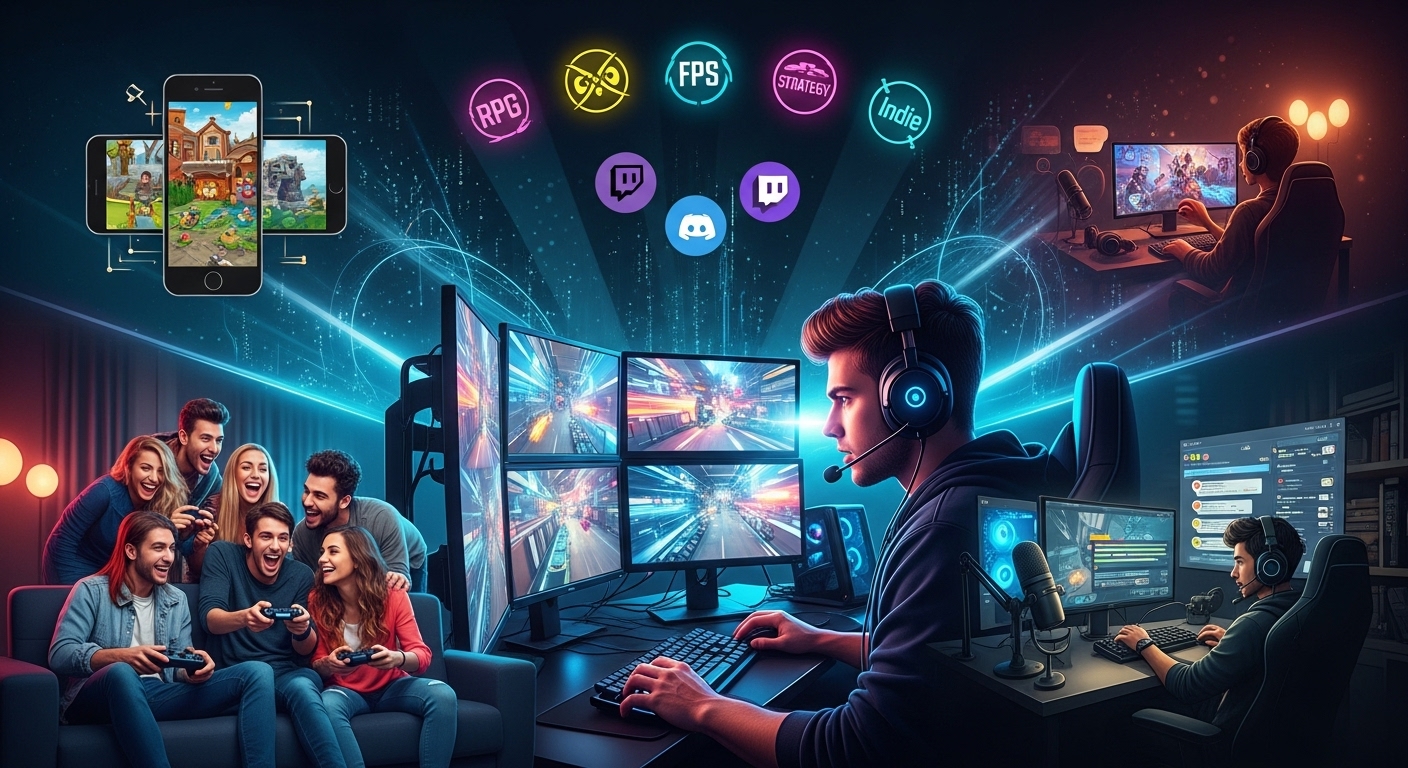Gaming has come a long way since the days of basic pixelated graphics and simple gameplay mechanics. Today, it’s a thriving multi-billion-dollar industry, providing entertainment, competition, and community for millions of people worldwide. From massive open-world games to the rise of esports, the gaming landscape is evolving faster than ever before. But what’s next? In this blog post, we will dive into the latest trends and technologies that are shaping the future of gaming, from virtual reality to cloud gaming and everything in between.
Virtual Reality: Stepping Into a New Dimension
Virtual reality (VR) is one of the most exciting innovations in the gaming world today. VR immerses players in entirely new worlds by using a headset and motion-tracking technology, allowing players to experience games in a way that was previously unimaginable. Titles like “Half-Life: Alyx” and “Beat Saber” have demonstrated the immense potential of VR gaming, offering experiences that engage players physically, emotionally, and mentally.
The future of VR gaming looks bright, with improvements in both hardware and software making it more accessible and affordable. High-quality VR headsets, such as the Oculus Quest and PlayStation VR, are now available at a lower price point, allowing more people to experience the magic of virtual worlds. Additionally, game developers are investing heavily in VR-exclusive titles, pushing the boundaries of gameplay mechanics and storytelling.
In the coming years, we can expect VR to become an even more integral part of the gaming experience, with more immersive worlds, improved interaction, and better graphics. As VR technology evolves, it could change how we experience not only games but also movies, social media, and even education.
Cloud Gaming: Playing Without Limits
Cloud gaming is quickly gaining traction as a game-changing trend in the industry. Rather than relying on powerful hardware to run games, cloud gaming allows players to stream games directly from remote servers. This means that players can access high-end gaming experiences on any device, whether it’s a smartphone, tablet, laptop, or even a smart TV, without needing expensive consoles or PCs.
Services like Google Stadia, Microsoft’s Xbox Cloud Gaming, and NVIDIA GeForce Now have already made strides in bringing cloud gaming to the masses. The beauty of cloud gaming is its accessibility; players no longer need to invest in top-tier hardware to enjoy graphically demanding games. All they need is a stable internet connection, and they can stream their favorite titles anywhere, anytime.
As internet speeds continue to improve with the rollout of 5G and fiber-optic networks, cloud gaming will only get faster and more reliable. This means that the gap between console and PC gaming could begin to shrink, giving players more options and flexibility. Additionally, the rise of cloud gaming could revolutionize multiplayer gaming, making it easier for friends and strangers around the world to connect and play together without worrying about hardware limitations.
The Rise of Esports: Gaming as a Professional Career
Esports, or competitive gaming, has exploded in popularity in recent years. What was once a niche activity is now a global phenomenon, with millions of fans watching professional gamers compete in tournaments with multi-million dollar prize pools. Titles like “League of Legends,” “Dota 2,” and “Fortnite” have turned competitive gaming into a legitimate sport, with players earning sponsorships, salaries, and endorsements, just like traditional athletes.
Esports tournaments are now broadcast on mainstream platforms like Twitch, YouTube, and traditional TV, attracting huge audiences and offering lucrative career opportunities for players, coaches, and commentators. The global reach of esports is unprecedented, with fans from every corner of the world tuning in to watch their favorite players and teams compete.
Esports is not just limited to high-level competitions; it has also made its way into schools and universities, where students are now offered scholarships for excelling in competitive gaming. As more institutions recognize the potential of esports, it is likely that we’ll see even more investment in the scene, leading to the development of professional leagues, larger tournaments, and greater exposure for players and teams.
Mobile Gaming: Gaming in the Palm of Your Hand
Mobile gaming has become one of the most popular forms of entertainment worldwide. Thanks to the widespread use of smartphones, players can enjoy a wide variety of games anywhere, anytime. From simple puzzle games like “Candy Crush” to expansive role-playing games (RPGs) like “Genshin Impact,” mobile gaming has something for everyone.
One of the key factors driving the growth of mobile gaming is accessibility. Mobile games are easy to pick up and play, and with app stores offering thousands of free-to-play and low-cost games, anyone can get started without needing a large investment. Additionally, mobile gaming has opened up opportunities for social gaming, where players can connect with friends, share experiences, and even compete in multiplayer matches while on the go.
The future of mobile gaming looks incredibly promising. With advancements in mobile hardware, such as improved processors, better graphics, and 5G connectivity, mobile games are becoming more sophisticated and graphically intense. Developers are also finding innovative ways to incorporate AR and VR into mobile gaming, enhancing the experience even further. As mobile technology continues to evolve, so too will the quality and depth of mobile games, pushing the boundaries of what can be achieved in the palm of your hand.
Open-World Games: Freedom to Explore and Create
Open-world games have become a dominant genre in modern gaming, offering players the freedom to explore vast, detailed worlds at their own pace. Games like “The Witcher 3,” “Red Dead Redemption 2,” and “Breath of the Wild” have set new standards for open-world design, offering immersive environments that react to player choices, dynamic weather systems, and a level of detail that makes the world feel alive.
The appeal of open-world games lies in the sense of freedom they provide. Players are not restricted to linear paths or levels; instead, they can forge their own paths, complete side missions, and interact with the world in countless ways. The worlds themselves are rich with lore, characters, and hidden secrets, making exploration an exciting and rewarding experience.
As technology improves, we can expect even more expansive and realistic open worlds. Advances in AI, procedural generation, and virtual ecosystems will allow developers to create even more dynamic, interactive environments. Whether it’s customizing vehicles, interacting with NPCs in new ways, or discovering new planets in a sci-fi adventure, the possibilities for open-world gaming are endless.
The Impact of Artificial Intelligence: Smarter, More Dynamic Games
Artificial intelligence (AI) is increasingly playing a crucial role in shaping the future of gaming. From smarter NPCs to adaptive difficulty systems, AI is enhancing gameplay experiences in ways that make games more engaging, challenging, and realistic.
In traditional games, NPCs often follow predictable patterns. However, AI-driven characters can now respond to player actions in real-time, making interactions feel more natural and unpredictable. This creates a more immersive experience, where players must think strategically and adapt to the evolving environment around them.
AI is also being used to create more dynamic and personalized gameplay experiences. Games can now adjust their difficulty based on the player’s skill level, ensuring that each player has a unique and challenging experience. As AI continues to evolve, we can expect even more sophisticated NPCs, enemy behavior, and gameplay mechanics that push the limits of what’s possible in gaming.
Conclusion: A Bright Future for Gamers
The future of gaming is more exciting than ever, with new technologies and innovations pushing the boundaries of what we can expect from video games. Virtual reality, cloud gaming, esports, and mobile gaming are just a few of the trends that are reshaping the gaming landscape, offering players new ways to experience their favorite titles.
As technology continues to evolve, the gaming industry will continue to provide thrilling, immersive experiences that allow players to explore new worlds, connect with others, and even make a living doing what they love. Whether you’re a casual gamer or a hardcore enthusiast, the future of gaming promises to be full of innovation, excitement, and endless possibilities.



